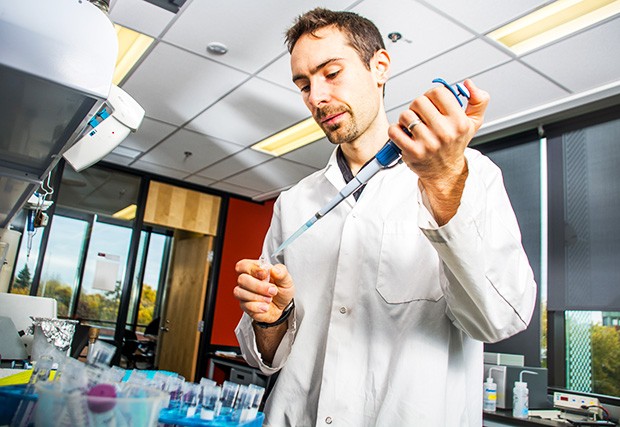Transforming toxic waste into green energy
 Damien Biot-Pelletier: “Concordia is the only place in Canada that offers applied research opportunities like this.” | Photo by Concordia University
Damien Biot-Pelletier: “Concordia is the only place in Canada that offers applied research opportunities like this.” | Photo by Concordia University
How can a struggling industry like pulp and paper in Canada be revived? According to Damien Biot-Pelletier, a Concordia PhD candidate in biology, the answer lies in synthetic biology.
“One of the by-products of pulping wood is what’s called spent sulfite liquor, which is extremely toxic,” says Biot-Pelletier, who participates in BioFuelNet Canada, a network that brings together the Canadian biofuels research community to address the challenges of an advanced biofuels industry.
“What my research is looking at is transforming this toxic product into biofuel. The net result for a pulp or paper mill would be that they could essentially become biorefineries and generate new streams of income from transforming waste and wood into green energy.”
In his lab at the Centre for Applied Synthetic Biology, Biot-Pelletier is building on the findings of a previous Concordia grad student: Dominic Pinel, who produced a strain of yeast that is resistant to sulfite liquor and transforms its sugars into ethanol — a biofuel.
Biot-Pelletier is now trying to discover what exactly made that specific strain of yeast resistant, so the knowledge can be applied to other yeast strains and other toxic mixtures.
“I’m taking the differences between this strain and wild yeast, and reintroducing them into wild yeast to see if it confers resistance and to what degree this is significant,” he says.
“Once this is figured out, it can be used to engineer yeast resistant to toxic mixtures similar to sulfite liquor, and be applied to create biofuels.”
Biot-Pelletier says ethanol can be used to power vehicles, but due to the amount of energy required for production, it’s not the greenest biofuel out there. “What I’m really hoping is that this research can be applied to the production of other biofuels, such as butanol and biodiesel. These fuels contain a lot more energy than ethanol, making them greener options.”
The potential for producing environmentally friendly technology in the emerging field of synthetic biology is part of what drew Biot-Pelletier to Concordia.
After completing a Master’s at McGill University in microbiology and immunology, he was itching to undertake applied research that could make a difference. “I knew I wanted to get into synthetic biology and Concordia’s Centre for Structural and Functional Genomics is the only place in Canada that offers applied research opportunities like this.”
For Biot-Pelletier, the real potential of his research lies in restoring balance in an industry that puts so much pressure on the environment. “Right now we are burning biomass from the ancient past and releasing carbon into the atmosphere. When you produce fuel from biomass, you insert our fuel consumption into the natural carbon cycle.”
Find out more about Concordia’s Centre for Applied Synthetic Biology.

